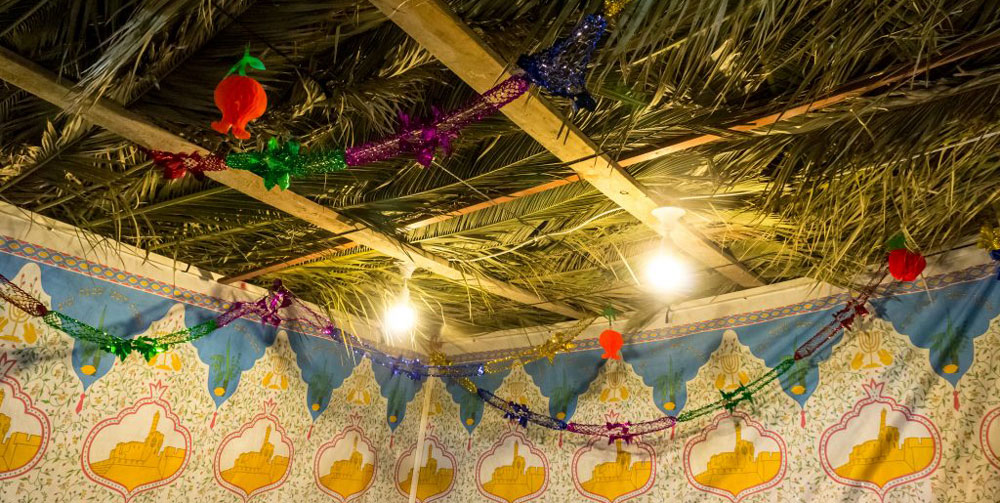Parenting Sukkot 2020: “And you shall celebrate in joy”?

The holiday of Sukkot begins Friday evening, October 2nd and is observed in several ways:
– building a sukkah (similar to a hut) outside one’s home,
– invoking and inviting our ancestors into our sukkah,
– shaking the lulav and etrog,
– attending services, and
– joyfully celebrating with family and friends with meals (and even sleeping!) in the sukkah.
Like everything else in 2020, some of these mitzvot (commandments) will be challenging to fulfill. Personally, the most challenging aspect of Sukkot will be to celebrate in joy, as the Torah commands “v’samachta b’chagecha, v’hayeetah ach sameach,” and you shall celebrate your festivals and be in JOY!
If anyone has poked their head out of their house, or looked online, we are currently experiencing many crises, nationally and globally: a pandemic, wildfires, systemic racial injustice, melting polar icecaps, a rise in anti-Semitism, collapsing institutions, extinction of species, financial stress, emotional stress, and a completely polarized country in which lies abound and truth is hard to find.
Enter Sukkot–and by the way—don’t forget to celebrate in joy!
My initial response: “Are you kidding me?”
My second response: “Who has time to be joyful?”
Realizing the cynicism in my responses, I took a pause and a very deep breath and spoke to myself.
My third response “Amy, how can Sukkot be relevant at this moment in time?”
In the Midrash (Vayikra Rabbah 30:14), it explains the lulav* and the etrog (citron) are correlated to various body parts: the palm to the spine, the myrtle to the eyes, the willow to the lips, and the citron to the heart. We are told how each of these body parts best enable us to praise God
With where we are today in the world, I invite you to think about how you can praise God using your spine, eyes, lips, and heart, and if you’re unsure of your belief in God, consider how you can use these body parts to make the world a better place. Perhaps, you will promise to stand upright with your spine like the palm, ready to fight for equal justice for all; maybe you will use your myrtle eyes to identify one specific problem you’d like to work on; perhaps you will open up your willow mouth and speak truth to power; or maybe you will choose to practice radical empathy with your etrog heart. When we recite the blessing over the lulav and the etrog, all four elements are bound together and held as one unit—so too, we must work together– embodying the lulav and the etrog, standing tall and not allowing ourselves to get knocked off our game as we approach life in 5781/2020 with open eyes, mouth, and heart, a heart big enough to love all of creation.
For as long as I can remember, rabbis have been teaching about the flimsy nature of the sukkah itself and how it represents the uncertainty in our own lives. This feels especially resonant in 2020. We do not know what the future holds. Who will be struck by Covid, or wildfires, or hunger, or financial collapse, or any other multitude of possibilities? And so my friends, this is where joy enters.
If it is true that our lives are like sukkot, here for a brief period of time, precarious, temporary structures that are vulnerable to the elements, why wouldn’t we choose to live our life in joy? Gazing up at the night sky, through the sukkah’s schach (grass or leaf ceiling), to see the stars we can admire the beauty in our world and dream of brighter days. Even with all the precariousness of the sukkah, why wouldn’t we choose to experience the best of what life can offer? Precisely because we do not know what life has in store for us is why I believe Judaism teaches us specifically on Sukkot to live in joy. To experience life in its sweetness, with family, with friends, (even if this year’s gathering is via Zoom or sitting around the outside of the sukkah and not inside, due to social distancing measures) with good food, with learning, with love, and with laughter.
So, I invite you, despite of all of life’s challenges, to find some time to celebrate this festival (and beyond) in joy!
*While the word lulav means palm frond, it refers in this context to the bundle of three different branches: the palm frond in the center with the hadas (myrtle) and aravah (willow) branches, one on each side. These three elements are all tied together as one bundle, even though it is referred to as the lulav.
Amy Grossblatt Pessah is a rabbi, author, spiritual director and mom. Serving various communities and demographics across the country, Amy has been a Jewish educator for over twenty-five years, with a specialization in Jewish Family Education. She is the author of the recent book, Parenting on a Prayer: Ancient Jewish Secrets for Raising Modern Children. Learn more at her blog, A Soulful Journey.

